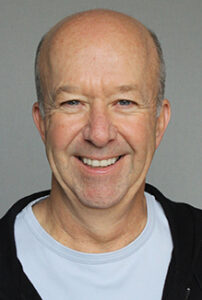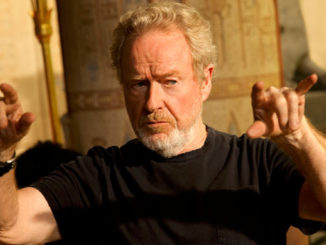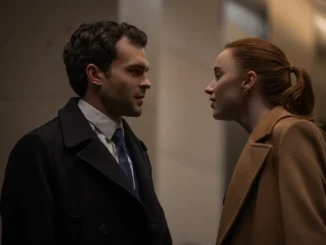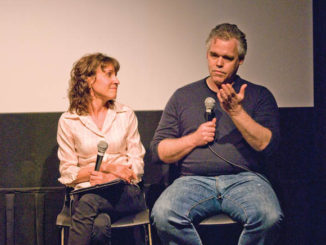
by Garrett Gilchrist
The job of the animation editor is often a misunderstood one. “Animation editors are still an enigma throughout the industry and even within the ranks of fellow editors,” claims Darren T. Holmes, ACE (How to Train Your Dragon, 2010; Ratatouille, 2007). “I take every opportunity to inform and enlighten anyone who will listen.”
“Some people still think we start cutting after the animation’s done,” says Catherine Apple (Hotel Transylvania, 2012; Gnomeo and Juliet, 2011). In fact, an animated film starts with the barest of materials: rough storyboards, temporary dialogue and a script that is far from final. “We’re on the film for a good year and a half before there’s any animation coming in. As soon as storyboards are done, we’re on the project. I’m sure people are surprised by that. We’re on it for the whole duration of the movie. We’re the last to leave.”
It’s a building process, according to Maryann Brandon, ACE (Kung Fu Panda 2, 2011; How to Train Your Dragon, 2010). “I talk to the story artists and convey what shots I need to make a scene work,” she explains. “They draw it, then I cut it together and figure out the changes and additional shots that are needed to tell the story.”
“Live-action features commit great resources and energy into producing the script,” Holmes adds. “The editor can only do so much with the material he is given. Even re-shooting scenes inevitably feels like an afterthought — because it is.
“In animation, the editor is able to build the whole story in pre-production by using storyboards with temp dialogue and music — before the larger production process even begins,” Holmes continues. “Many of the structural, pacing and character problems that may not be discovered until after principal photography in live action can be recognized at this early stage. It is like being able to project your script, and almost as easy to make changes as if you were still in Final Draft.”

Photo by Gregory Schwartz
Clare Knight, ACE (Kung Fu Panda 2, 2011; Kung Fu Panda, 2008), says, “An animation editor doesn’t build a film once at the completion of production, but tears it apart and assembles it over and over again throughout the whole process. She becomes the keeper of story and must have an encyclopedic knowledge of all elements that go into the narrative, pace and visuals of the picture. The late editor Ralph Rosenblum wrote a book about film editing titled When the Shooting Stops, but in animation editing, it never stops. The war goes on for three years.”
Brandon, who also edits live-action blockbusters like the upcoming Star Trek Into the Darkness (2013) and Mission Impossible III (2006), offers, “In live action, I have a work bin of shots and, like a puzzle, I configure and reconfigure them until I have the story I want to tell, and the way I want it told. Many times I’ve asked for additional shots on live-action films. But in animation, there is a tendency to have an evolving script. That has its good and bad points. If a better idea comes out of seeing something on the screen, we change the shots to tell a better story. The bad part is that this process can go on and on, and at some point there is a moment where one must commit to the story and make it work.”
Says Holmes, “Oftentimes the directors are also the writers, so you are in the middle of the process with them. The edit room is also the writing room. Many suggestions given in the cutting room can become jokes, lines of dialogue or whole scenes that make it into the final film. Whole or partial scenes can be moved without worrying about continuity. Dialogue can be adjusted and many alternates can be auditioned. Characters can be changed or even combined to simplify a plot point. And because the animation process can take a couple of years, if you find that you do want a re-shoot or an insert, you don’t have to call everyone back to do it.”
Without the polished distraction of beautiful, finished animation, these rough Leica reels, featuring only roughly drawn still images, shine a very harsh light on any problems the story has, and any scenes which simply aren’t working.
“The thing I absolutely love about editing animation is that my role as editor really becomes part director as well, and that is very satisfying,” says Brandon. “The editor of any film has to be a storyteller and a performance enhancer, and use the best shots to make the film look as good as possible. The more I can be involved with those artistic aspects, the more satisfying the project for me.”
Knight adds, “You never know from where a solution to a problem will emerge, and what effect it will have on the life of a film. During Madagascar, the native villagers were seen in the shots almost aimlessly dancing. There was a vacuum in the tone. A song that I had danced to when I was younger came to mind, which was ‘I Like to Move It.’ It became not only a cohesive theme for the sequence, and an aural backdrop for the film, but a marketing tool for merchandising the animated series and subsequent sequels.”
There’s no doubt that the better- animated films are not just beautiful to look at but also big business. Animated films are consistently among the top-grossing films at the worldwide box office. Yet they are often overlooked at awards season, and not taken as seriously. And until last year, the International Animated Film Society’s (ASIFA-Hollywood) own Annie Awards, animation’s highest honor, didn’t even recognize editing.
Brandon remembers, “I was working with Darren Holmes on How to Train Your Dragon, and I didn’t know there was such a thing as the Annies. He explained to me that they were for animation only, and I was outraged to find out that editors weren’t represented. I encouraged Darren to get it recognized by the Annies, at which point he got Stephen Rivkin involved.”
“Steve Rivkin and I go way back,” Holmes recalls. “I assisted him on four films. I made the presentation to the ASIFA board for the inclusion of editing in the Annies.” Rivkin edited the first three Pirates of the Caribbean films, but also James Cameron’s mostly animated blockbuster Avatar.
“Steve got us all to write letters,” Brandon remembers. Rivkin has been heading a joint initiative by the Editors Guild and American Cinema Editors [ACE] to garner more recognition from film festivals, critics associations and film societies that don’t currently award or acknowledge the art of editing. (See related story, page 14.)
Last year, the Annies gave its first ever Editing in a Feature Production Award to Craig Wood, ACE, for his work on Rango from live-action director Gore Verbinski (Pirates of the Caribbean), as well as an Editing in a Television Production Award to the editing staff of Penguins of Madagascar. In February, the Annies awarded their second editing awards to Nicholas C. Smith, ACE; Robert Grahamjones, ACE; and David Suther for the feature Brave, and the editing crew of the TV episode Kung Fu Panda: Monkey in the Middle.

Says Knight, “I was gratified to have been nominated for the first editing award at the Annies, but am even more enthused that the ACE Eddie Awards view animation editing as worthy of recognition.” She is quick to point out that with the proliferation of CGI effects, the line between animation and live action has blurred, and live-action directors and editors are now working on animated films using live-action techniques, such as Steven Spielberg’s The Adventures of Tintin (edited by Michael Kahn, ACE).
“So many tools that I use on a daily basis are becoming more and more a part of the live-action arena, through CGI and stereoscopic 3D,” Knight continues. “I suppose the community needed to know what we did before it could be appreciated.”
“I think it’s great that animation editors are being recognized,” says Apple. “I don’t think anyone really knows how much work we do on a film. Besides the creative work, we also do a lot of technical work. Everything has to go through editorial first: storyboards, layout, rough animation, final animation, lighting… At every stage we re-cut, and sometimes the timing changes based on what the animators have done.”
As animation editor H. Lee Peterson, ACE (Madascar: Escape 2 Africa, 2008; Aladdin, 1992), points out, “Animated films require that you edit the film over and over as you do each phase. That’s story, layout, animation…” Thinking back to his time as an assistant on The Little Mermaid (1989), he recalls, “That was before we used Avids and film was still in the editing room. The transition from film to digital was the most difficult part of the learning curve.” For Peterson, the switch came halfway through Pocahontas. He remembers seeing the early, rough reels for The Lion King, which were very roughly drawn with an incomplete script. They were terrible, he says, but the film (edited by Ivan Bilancio) gradually got better and better — a perfect example of how animation editing works.
The art of animation editing has changed drastically over the past 15 to 20 years. In 1991, when Knight was assisting Nick Fletcher on Amblimation’s American Tail II, she recalls, “The process of viewing dailies consisted of the camera department shooting 35mm film, which was sent to the lab. We waited overnight for it to be developed. I came in at the crack of dawn and cut the shots in order, usually no more than five or seven shots. We projected them forward and backward to the assembled heads of departments.
“I then physically carried them upstairs and placed them on a KEM, where the same people sat huddled under a large black tent watching the shots forward and backward again,” Knight continues. “This was called ‘the Sweatbox,’ and it was aptly named. Today, the animator can finish changes to his shots and save them to a server 10 minutes before screening dailies. Changes are made and the shots are approved by the director and sent to the editor before morning coffee.”
Peterson notes, “With the advent of the virtual camera in layout, the challenges of cutting have become much more like a live-action film.” He remembers a screening in the late 1980s when the executives asked for B-roll and alternate takes, and everyone snickered. In traditional animation, there were no alternate angles. In CGI, it’s possible to move the camera and make changes to a scene even after it’s animated.
“With the new tools available in CG, the editor is now the driver of many creative elements of the filmmaking process,” Holmes explains. “We can explore sets and camera options to the fullest, adding actions or experiences that wouldn’t have been possible five or 10 years ago. The directors and story artists still give you the template for the visual representation of the story, but once the pre-visualization process starts, the editor is vital to ensuring that each scene is the most dynamic that it can be. We can truly ‘ask for a shot’ and it can be made. We can ask that shots be combined. We can change the speed of moves and pans as needed to fit the pace and style of the scene.”
Brandon adds, “CGI brings live action and animated cutting closer together. That said, most CGI shots in live-action still have a ‘real’ component to them. In animation, your imagination is the guide, which has produced some extraordinary experiences on the screen.”

Editing in stereoscopic 3D presents its own challenges, doubling the render time needed and the amount of data required. Editors have to be sure their cuts would work projected in 3D in a theatre and not strain the audience’s eyes. “When we went from 2D to 3D, we originally thought we would have two cuts: one flat and the other in stereoscopic 3D,” explains Knight. “We also thought that the mind would need more time to take in the added information. That was not the case. The separate cuts are not 2D and 3D, but the left and right eye.”
“Over time, we’ve all gotten used to putting together sequences in stereo,” Knight continues. “Everything is now authored in three dimensions, so looking ‘across a cut’ involves all possible results in an immersive virtual universe. Where will the character land? What’s the focus of the background? What’s the camera angle and how is it lit? These are all important questions on every single cut. It’s a minefield, and we now need pre- visualization to help guide our way through.”
An animation editor needs a very diverse set of talents, notes Holmes. “Starting from scratch, you have to build the whole soundtrack as you go. That includes every footstep, door knock, cloth rub and explosion. All of the temp music is built in the Avid — sometimes with suggestions from directors or artists, but mostly by just scouring hours of similarly themed movie scores.”
The best part of the sound experience for Holmes is cutting dialogue. “Not being tied to film takes from several camera angles, there’s no limit to the manipulation that can be done with the dialogue — even manufacturing lines from several takes,” he explains. “If one word was flubbed on a great take, you can replace just that word or find a better inflection as needed. Pacing can be controlled completely by taking out air or speeding or slowing a line or two — or 12. On Ratatouille, Ian Holm, who played Skinner, was in poor health for a fair amount of the recording sessions, so his performances were a bit subdued. But by using speed compression at about 85 percent, I was able to make him sound like the manic OCD chef that you saw.”
Peterson agrees. “You’re creating performances in a way that’s unique to animation,” he says. The audio track is what the animators animate to, so you want the performance to express the emotion of the moment.” As the Genie in Aladdin, Robin Williams was endlessly improvising at the microphone, performing a huge amount of material. Peterson had to select ad-libbed lines which were not just funny, but true to the character and story. He remembers having a transcript printed of everything Robin Williams said in his sessions. He cut out the lines he wanted to use and Scotch-taped them together to form a new script. “It looked like a ransom note,” he recalls. Today, that would be done on a word processor or through work with the actual takes.
When asked to describe the difference between editing live action and animation, Peterson says, “Animation editing is like architecture. You set out a plan and then start building. There are many opportunities to shape the film as you go along, but you need to have a road map, which is created in the storyboard phase. Call it the blueprint.”
Holmes has his own analogy: “Live action is like carving a statue from stone. You’re given a finite amount of material with an inherent shape, and you can only whittle away so much within that structure without compromising its strength. Animation is like sculpting with clay. You keep adding on until a form starts to take shape. You’re still able to move portions from one side to another, adding internal support if needed when extremities get too long, and you can still trim it back, even when you’re near the final form.”
Animated films are some of the highest grossing at the box office, although they’re often overlooked and not taken seriously in terms of filmmaking. “But they’re more recognizable than many live-action films,” Apple points out. “Every time I mention an animated movie I’ve worked on, everybody’s heard of it. They reach more people, and that’s great.”






